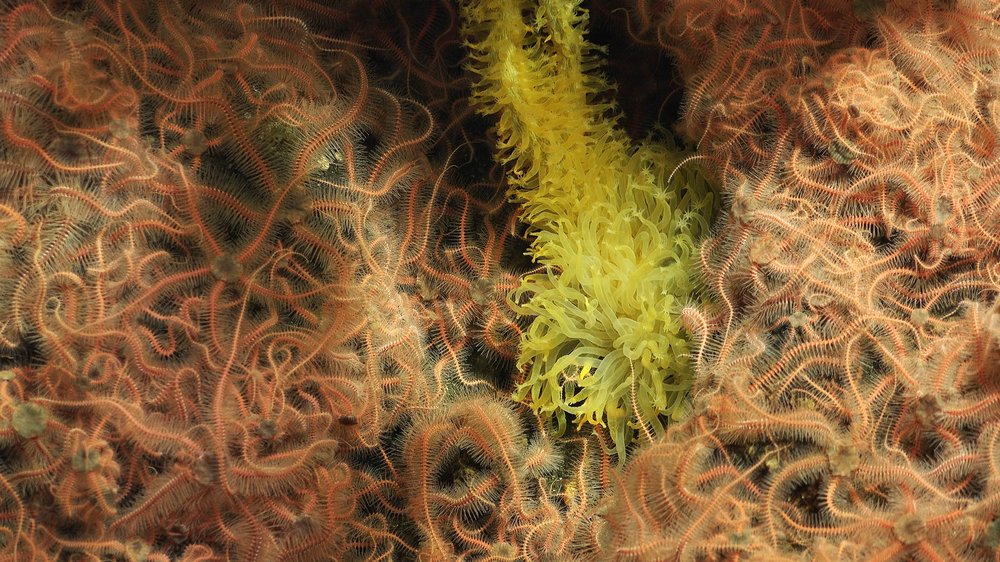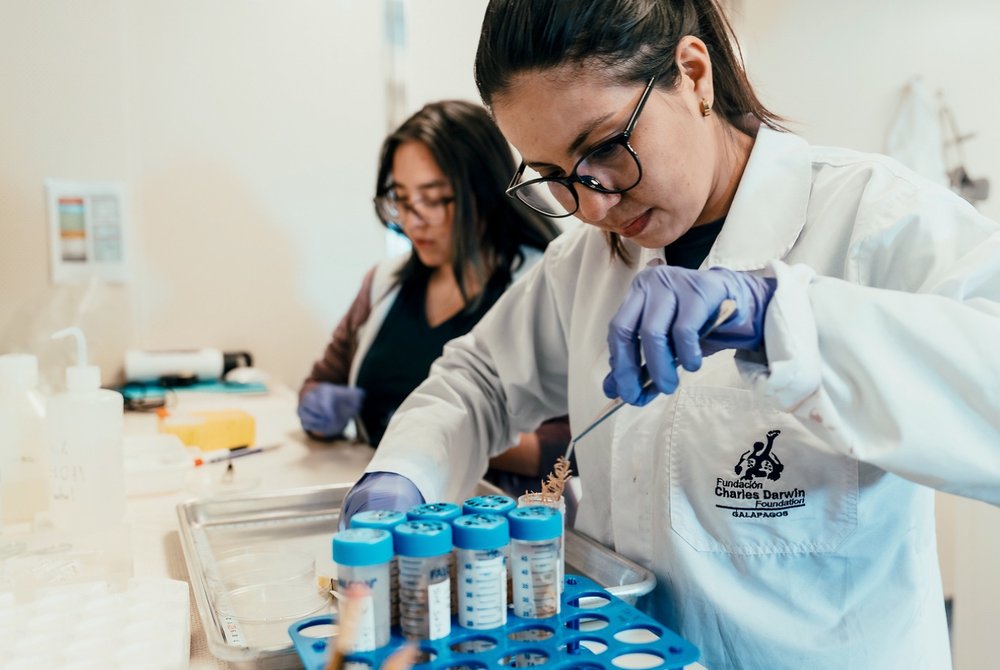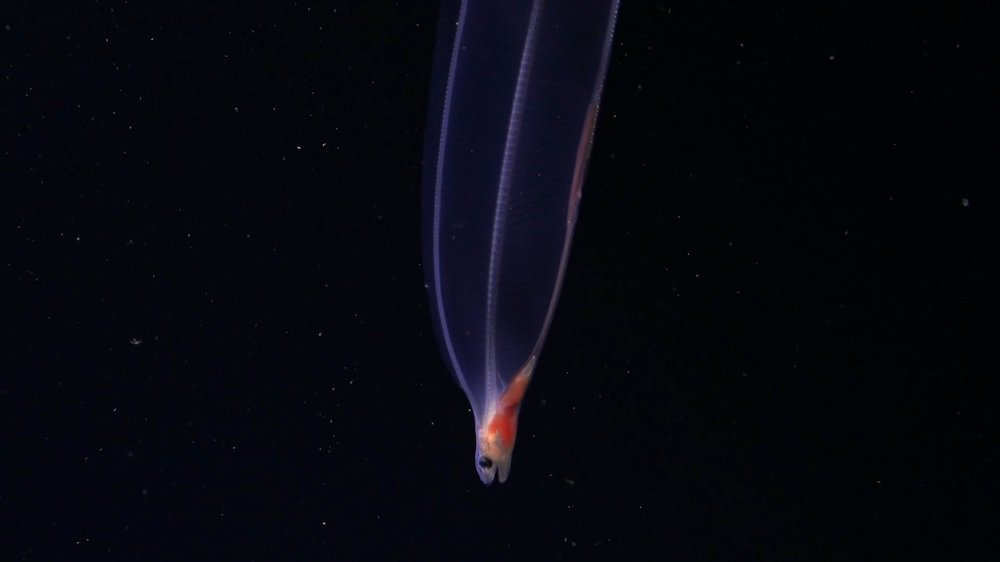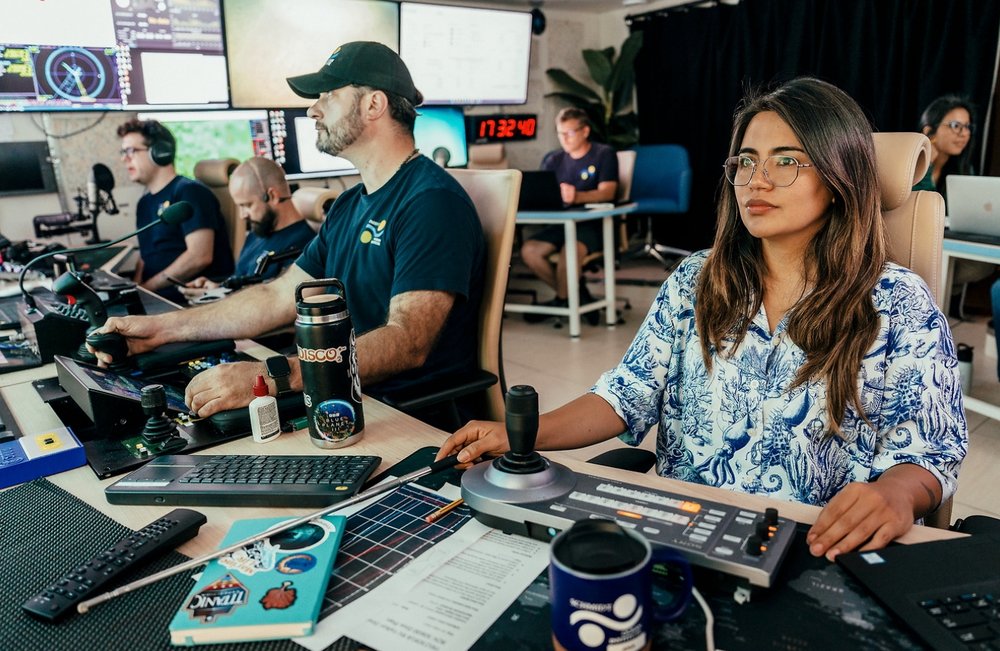Stunning 800-meter long coral reef discovered with Schmidt Ocean Institute's underwater robot off Galápagos Islands
Scientists examining underwater cliff ecosystems onboard research vessel Falkor (too) using the 4,500-meter robot, ROV SuBastian, have discovered two pristine coral reefs in the waters surrounding the Galápagos Islands. These newly identified cold-water reefs are situated at depths ranging from 370 to 420 meters. The discovery expands our understanding of deep reefs within the Galápagos Islands Marine Reserve.
The larger of the two reefs spans over 800 meters in length, the equivalent of eight football fields. The second, smaller reef measures 250 meters in length. They exhibit a rich diversity of stony coral species, suggesting that they have likely been forming and supporting marine biodiversity for thousands of years. This discovery follows the April 2023 finding of the first deep coral reefs in the Galápagos Marine Reservee by scientists onboard Woods Hole Oceanographic Institution’s R/V Atlantis diving in the HOV Alvin submersible.

One goal of the expedition was to apply laser scanning technology for creating extremely high-resolution maps of these reefs. The laser scanner produced two-millimeter resolution maps capable of identifying animals living on the seafloor. Because of the coarse resolution, most underwater mapping technology cannot image living organisms.
In addition to discovering the reefs, scientists uncovered two uncharted seamounts and mapped them to a high resolution. The seamounts were suspected to exist based on satellite data and are now confirmed.
“This information is not only valuable from a scientific perspective, but it also provides a solid foundation for decision-making that effectively protects these ecosystems, safeguarding the biological diversity they harbor and ensuring their resilience in a constantly changing environment. The geological dynamics of the region play a fundamental role in the deep-sea ecosystems. Research and mapping are essential tools to ensure that the Galápagos continue to be an iconic example of the beauty and importance of nature," stated Danny Rueda Córdova, director of the Galápagos National Park Directorate.
The 30-day expedition began on 18 September 2023 and was led by Dr. Katleen Robert of the Fisheries and Marine Institute of Memorial University of Newfoundland and Labrador. The expedition included 24 participating scientists representing 13 organizations and universities including the Galápagos National Park Directorate (GNPD), Charles Darwin Foundation (CDF), the Ecuadorian Navy’s Oceanographic and Antarctic Institute (INOCAR), National Geographic Society, Monterey Bay Aquarium Research Institute (MBARI), University of Bristol, Woods Hole Oceanographic Institution (WHOI), University of Costa Rica, the UK National Oceanography Centre, Institut de Ciencies del Mar in Barcelona, Spain, and the University of East Anglia-UK.

“We are thrilled our mapping data are able to improve our understanding of reef ecosystems in the Galápagos,” said Dr. Robert, “The interdisciplinary science team is excited that the data collected during this expedition will contribute to growing knowledge on the Galápagos National Marine Reserve and contribute to the management of the Eastern Tropical Pacific Marine Corridor.”
In addition to investigating coral biodiversity in the Galápagos, the scientists explored areas within the Isla del Coco National Marine Park, a protected area managed by Costa Rica. The team, led by National Geographic Explorer Ana Belen Yanez, explored seamounts south-west of Isla del Coco and examined links between coral communities on seamounts in the Galápagos and those in Costa Rica. On one of the ROV dives, the researchers observed multiple deep-sea coral species laden with eggs. This research contributes data to inform the management of the Eastern Tropical Pacific Marine Corridor, a network of interconnected marine reserves managed by the governments of Ecuador, Costa Rica, Panama, and Colombia.
“The Galápagos Marine Reserve is an area of outstanding biological importance, connected to partner marine protected areas across the Eastern Pacific. Finding such deep and long-lived reef takes us important steps closer to protecting hidden dimensions of ocean diversity and understanding the role that deep habitats play in maintaining our ocean’s health,” said CDF’s Stuart Banks. “These fascinating new findings continue to feed important research to inform better management of existing and future marine protected areas in the region.”

“The Galápagos and Costa Rica Marine Reserves are globally renowned for their pristine beauty and Schmidt Ocean Institute is honored to be operating several expeditions in this part of the world,” said Jyotika Virmani, executive director of Schmidt Ocean Institute. “This is our second of three expeditions, and it is amazing that the scientists who sail on R/V Falkor (too) continue to find hotbeds of biodiversity each time we send ROV SuBastian down to the seafloor.”

For media enquiries, please contact:
Charles Darwin Foundation
Ambre Tanty-Lamothe
ambre.tanty@fcdarwin.org.ec
Galápagos National Park Directorate
Rosa León
rleon@galapagos.gob.ec | +593 96 985 4231
Schmidt Ocean Institute
Carlie Wiener
cwiener@schmidtocean.org | +1 808 628 8666
About the Organizations
Schmidt Ocean Institute was established in 2009 by Eric and Wendy Schmidt to catalyze the discoveries needed to understand our ocean, sustain life, and ensure the health of our planet through the pursuit of impactful scientific research and intelligent observation, technological advancement, open sharing of information, and public engagement, all at the highest levels of international excellence. For more information, visit www.schmidtocean.org.
The Galapagos National Park Directorate is responsible for conserving the ecological health and biodiversity of the insular and marine ecosystems of the protected areas. They also ensure the rational use of goods and services that the protected areas generate for the community.
Since 1959, the Charles Darwin Foundation has worked in close partnership with the Galápagos National Park Directorate to protect the Islands’ natural resources and share scientific results for the conservation of this living laboratory. More than one hundred scientists, educators, researchers, support personnel and volunteers from all over the world have participated in this effort. Currently, more than 75% of the staff are Ecuadorian citizens. The Charles Darwin Foundation is committed to the professional development of permanent Galápagos residents as future scientists, for the well-being of the islands and the nation in general. For more information visit: www.darwinfoundation.org
Instituto Oceanográfico y Antártico de la Armada (INOCAR) is a technical body of the National Maritime Authority of Ecuador and serves as the National Hydrographic Service. It performs several functions related to hydrography and marine navigation, including hydrographic surveying, chart production, maintenance of aids to navigation, oceanic condition monitoring, provision of weather forecasts, and issuance of tsunami alerts. INOCAR also plays a pivotal role in controlling and monitoring oceanographic exploration and research activities to ensure their effective execution and alignment with national regulations. For more information visit: www.inocar.mil.ec
The Fisheries and Marine Institute (MI) of Memorial University has worked closely with industry to answer research questions of importance to the economic development of Newfoundland and Labrador. The research enterprise has evolved tremendously since that time but the focus on research with an impact remains the same. Today, teams of highly qualified researchers, technical staff, support staff and graduate students are using world class infrastructure to answer research questions of local, national and international importance in the areas of fisheries, ocean safety, maritime operations, and ocean technology. For more information visit: https://www.mi.mun.ca/




